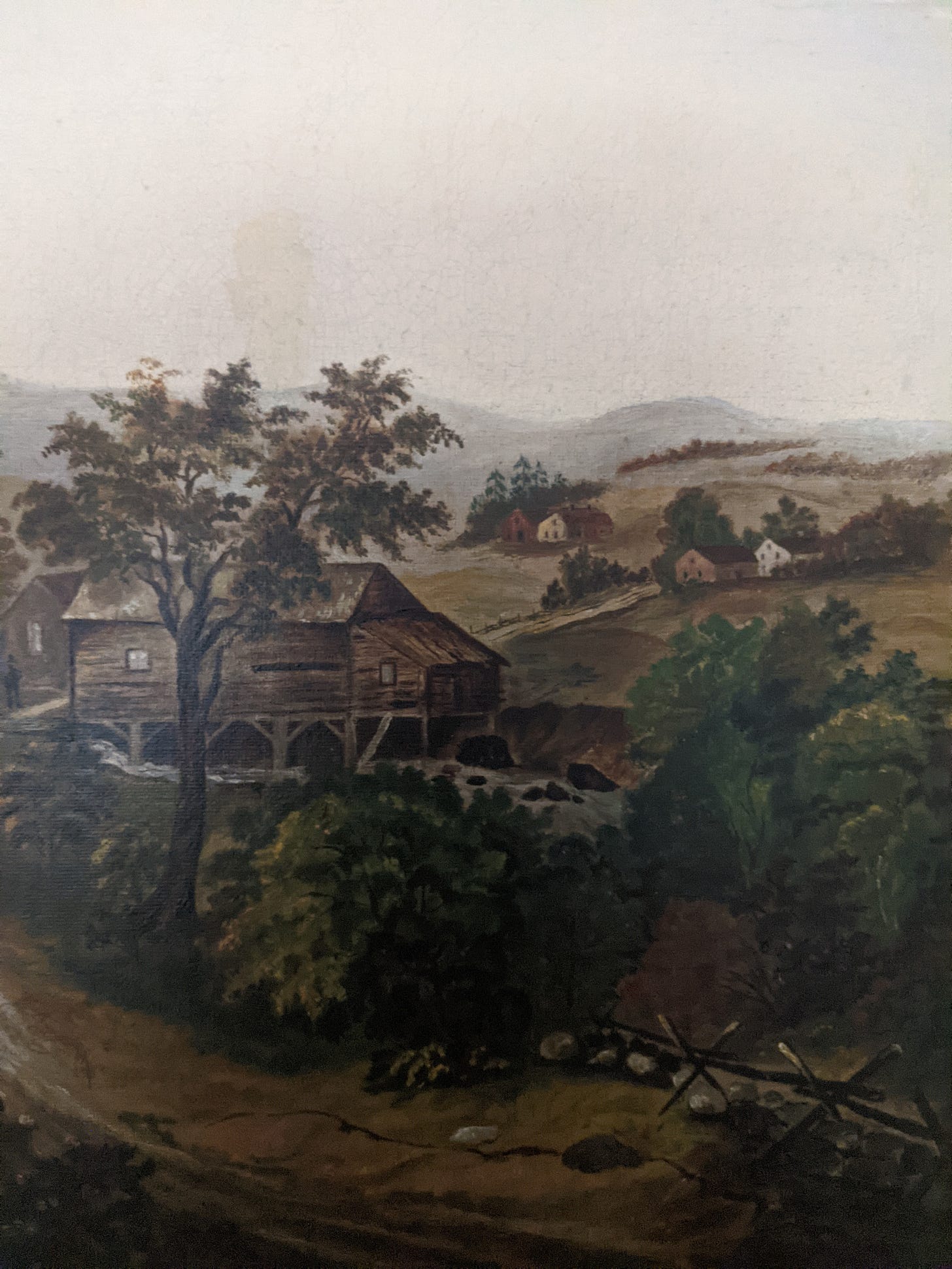Dear History Buzz reader,
I’ve been away for a while spending time with my family and I’m looking forward to getting back to writing for the Buzz!
I am so grateful to the amazing team of History Buzz researchers and writers who have kept the Buzz buzzing for the past few months. Although I’m not back 100%, I wanted to touch base with you with a short post and share this 19th century American landscape painting from the History Center’s collection.
American landscape painting.
Landscape painting began to dominate American art in the early part of the 19th century with idealized images of a vast, unspoiled wilderness that reflected a nation whose identity and belief in its boundless prospects were deeply interwoven with its natural environment. 1
We don’t have much about it.
The catalog description is pretty basic:
Donor: Constantine Tsaousis
Donor purchased painting in Maine. Appraiser described scene as "Man on White Workhorse near a Mississippi Dam"
Landscape. Man on workhorse in foreground; dirt road, mill and stream in lower right quadrant with houses in background; center and upper left quadrant with lake or river backed by mountains; sailboat on river. Canvas relined; stretcher held into simple gilded frame with small wooden strips tacked into place.
The artist is not known.
The donor, Constantin Tsaousis, was a conservator for Oliver Brothers in Boston.2 He lived in Boston, according to the catalog record. Oliver Brothers have done some conservation work for the History Center over the years.
The donor’s connection to the History Center isn’t clear . . . yet.
I’d like to do a little more looking to learn more about him. According to an oral history, he and conservator Carroll Wales did work at Phillips Academy.
I’ll do a little more digging and be back if there’s more story to explore (and there usually is!).
In the meantime, let’s take a closer look.
What do you think his story might be? Coming home after helping a neighbor?
Then there’s this man standing by the mill. You can see the stream running from the river under the mill. Or maybe it’s a pond or lake? What kind of mill could it be? A grist mill, grinding grain into flour? A textile mill? Or maybe a saw mill?
There’s also a sailboat. The water looks pretty still, and the sails are a little loose. Maybe the sailor stopped to fish? Or maybe the wind died and they’re waiting for it to pick up? Or maybe the breeze is just strong enough to gently push the sailboat long.
Perhaps the horse an rider live in one of the farms shown in the distance.
There are many details if you can look closely enough. If the scene is as the appraiser described, "Man on White Workhorse near a Mississippi Dam,” what might these flowers be? Leave a comment if you know!
Last May, I wrote a piece about learning to look at works of art. You can read that piece here.
I hope to be back writing for the Buzz very soon! Please leave a comment, or drop me a line. I love hearing from our readers!
Thanks for reading!
~Elaine
https://www.artistsnetwork.com/magazine/a-brief-history-of-landscape-painting/
Resources about the donor
https://icfadumbartonoaks.wordpress.com/2014/05/06/carroll-wales-part-ii-the-samatya-fresco/
https://archive.dartmouthalumnimagazine.com/article/1968/11/1/caroll-wales-and-constantine-tsaousis
https://oliverbrothersonline.com/constantine-tsaousis-cleaning-an-icon-at-hilandar-monastery-c-1971-photo-by-carroll-wales-bf-s-1998-0693/#4
https://www.aaa.si.edu/download_pdf_transcript/ajax?record_id=edanmdm-AAADCD_oh_215153











The painting definitely follows the (at the time) classic sweeping vista works done by the contemporary landscape artists of the day. I like it because the eye is drawn to the curve of the road on the bottom right and begs the question, where is the man on the horse coming from - he's not on the main road. That section of the painting is dark and industrial looking. In contrast, the middle, left and upper section of the painting is all about light and the serenity of a boat sailing on the calm water framed by the mountains and houses in the background. I'm not an artist but I like the 3 sections of the painting - light, dark and human/animal.
Regarding the mill - I see no signs of a messy lumber mill. Instead, the scene is serene. The builder of the mill has gone to great lengths to build on stilts over the stream rather than on the bank. There also appears to be a simple bridge where the road passes over the stream. Looking at the embankment behind the mill, could mean the water is really flowing into, not out of the large body of water. But then, I don't think we were supposed to look at details, it's an idealistic landscape after all. It was probably hung in the parlor of an urban home as a visual escape from the crowd and noise of the city.
Just a thought but how about another possible location, from our personal travels, paintings and railroad photos this picture makes me think of the Hudson River Valley with its hills and yes, mountains - a wide river rather than a lake or millpond? I did look up Hudson River School of painting. One especially, by William John Hill (1819-1879) His "Hudson River Landscape" is more elaborate than our painting but late enough to show telegraph poles. There is a similar scene of deer grazing in the lower Left-hand corner. rather than our man and horse. It is eBay item 275085491882 - $3898.